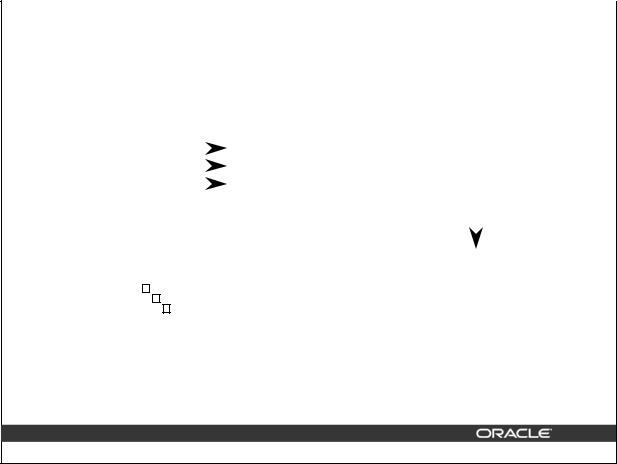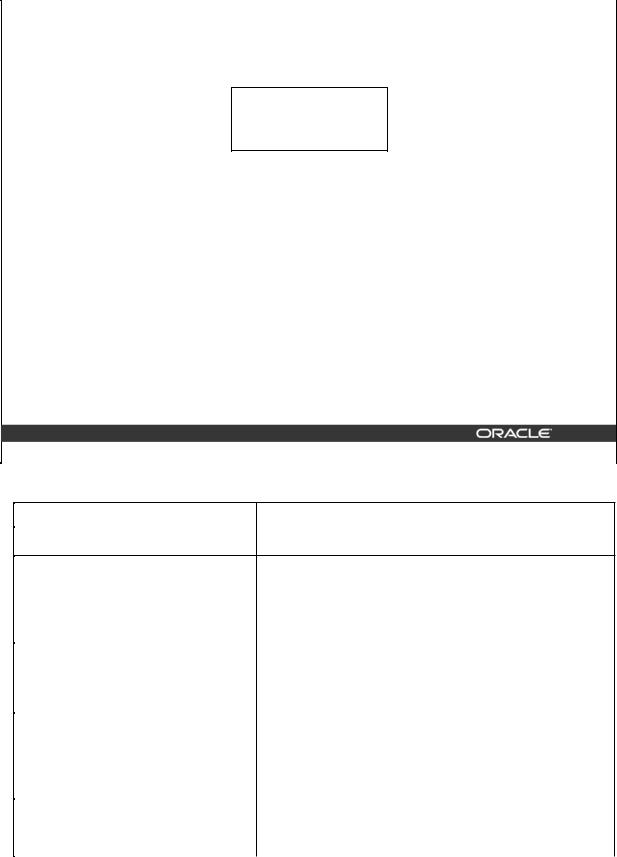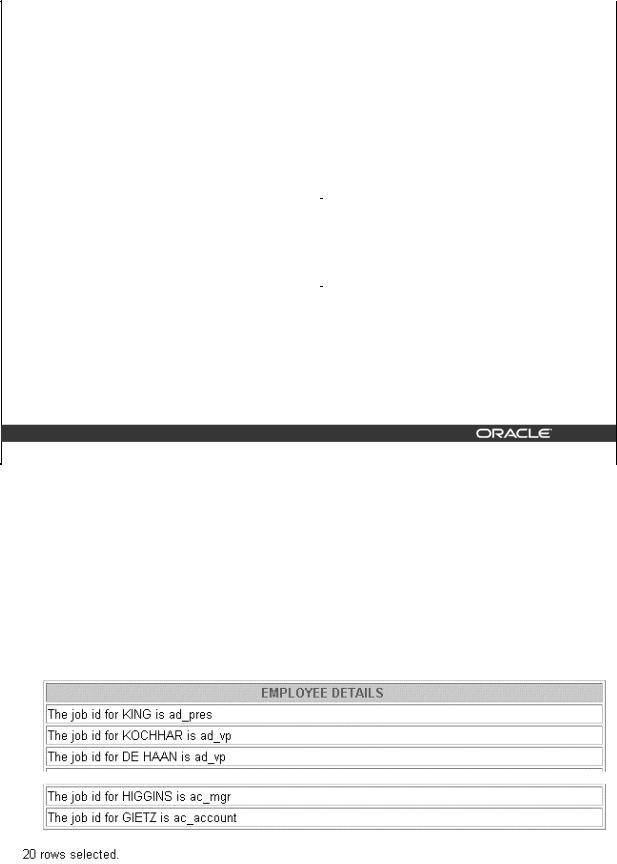
Semestr2 / 1 - Oracle / Student_1-8
.pdf
Single-Row Functions
Copyright © Oracle Corporation, 2001. All rights reserved.

Objectives
After completing this lesson, you should be able to do the following:
•
•
Describe various types of functions available in SQL
Use character, number, and date functions in SELECT statements
•Describe the use of conversion functions
3-2 |
Copyright © Oracle Corporation, 2001. All rights reserved. |
Lesson Aim
Functions make the basic query block more powerful and are used to manipulate data values. This is the first of two lessons that explore functions. It focuses on single-row character, number, and date functions, as well as those functions that convert data from one type to another, for example, character data to numeric data.
Introduction to Oracle9i: SQL Basics 3-2

SQL Functions
Input |
|
|
|
|
|
|
|
|
|
|
|
|
Function |
|
|
|
Output |
|||
|
|
|
|
|
|
|
|
|
|
|
|
|
|
|
||||||
|
|
|
|
|
|
|
|
|
|
|
|
|
|
|
|
|
|
|
|
|
|
|
|
|
|
|
|
|
|
|
|
|
|
|
|
|
|
|
|
|
|
|
|
|
|
|
|
|
|
|
|
|
|
|
|
|
|
|
|
|
|
|
|
|
|
|
|
|
|
|
|
|
|
|
|
|
|
|
|
|
|
|
|
|
arg 1 |
|
|
|
|
|
|
|
|
|
|
Function |
|
|
|
|
|
|||
|
|
|
|
|
|
|
|
|
|
|
|
|
|
|
performs action |
|
|
|
|
|
|
|
|
|
|
|
|
|
|
|
|
|
|
|
|
|
|
|
|
|
|
|
|
arg 2 |
|
|
|
|
|
|
|
|
||||||||||
|
|
|
|
|
|
|
|
|
|
|
||||||||||
|
|
|
|
|
|
|
|
Result |
|
|||||||||||
|
|
|
|
|
|
|
|
|
|
|
|
|
|
|
|
|
|
|
||
|
|
|
|
|
|
|
|
|
|
|
|
|
|
|
|
|||||
|
|
|
|
|
|
|
|
|
|
|
|
|
|
|
|
|
|
value |
|
|
|
|
|
|
|
|
|
|
|
|
|
|
|
|
|
|
|||||
|
|
|
|
|
|
|
|
|
|
|
|
|
|
|
|
|||||
|
|
|
|
|
|
|
|
|
|
|
|
|
|
|
|
|
|
|
|
|
|
|
|
|
|
|
|
|
|
|
|
|
|
|
|
|
|
|
|
|
|
|
|
|
|
|
|
|
|
|
|
|
|
|
|
|
|
|
|
|
|
|
|
|
|
|
|
|
|
|
arg n |
|
|
|
|
|
|
|
|||||
|
|
|
|
|
|
|
|
|
|
|
|
|
|
|
|
|
|
|
|
|
3-3 |
Copyright © Oracle Corporation, 2001. All rights reserved. |
SQL Functions
Functions are a very powerful feature of SQL and can be used to do the following:
•Perform calculations on data
•Modify individual data items
•Manipulate output for groups of rows
•Format dates and numbers for display
•Convert column data types
SQL functions sometimes take arguments and always return a value.
Note: Most of the functions described in this lesson are specific to Oracle’s version of SQL.
Introduction to Oracle9i: SQL Basics 3-3

Two Types of SQL Functions
Functions
Single-row
functions
Multiple-row
functions
3-4 |
Copyright © Oracle Corporation, 2001. All rights reserved. |
SQL Functions (continued)
There are two distinct types of functions:
•Single-row functions
•Multiple-row functions
Single-Row Functions
These functions operate on single rows only and return one result per row. There are different types of single-row functions. This lesson covers the following ones:
•Character
•Number
•Date
•Conversion
Multiple-Row Functions
Functions can manipulate groups of rows to give one result per group of rows. These functions are known as group functions. This is covered in a later lesson.
For more information, see Oracle9i SQL Reference for the complete list of available functions and their syntax.
Introduction to Oracle9i: SQL Basics 3-4

Single-Row Functions
Single row functions:
•Manipulate data items
•Accept arguments and return one value
•Act on each row returned
•Return one result per row
•May modify the data type
•Can be nested
•Accept arguments which can be a column or an expression
function_name [(arg1, arg2,...)]
3-5 |
Copyright © Oracle Corporation, 2001. All rights reserved. |
Single-Row Functions
Single-row functions are used to manipulate data items. They accept one or more arguments and return one value for each row returned by the query. An argument can be one of the following:
•User-supplied constant
•Variable value
•Column name
•Expression
Features of single-row functions include:
•Acting on each row returned in the query
•Returning one result per row
•Possibly returning a data value of a different type than that referenced
•Possibly expecting one or more arguments
•Can be used in SELECT, WHERE, and ORDER BY clauses; can be nested
In the syntax:
function_name is the name of the function.
arg1, arg2 is any argument to be used by the function. This can be represented by a column name or expression.
Introduction to Oracle9i: SQL Basics 3-5

Single-Row Functions
Character
General |
|
|
|
Number |
|
Single-row |
|
||
|
|
|
|
|
|
|
functions |
|
|
|
|
|
|
|
Conversion |
Date |
3-6 |
Copyright © Oracle Corporation, 2001. All rights reserved. |
Single-Row Functions (continued)
This lesson covers the following single-row functions:
•Character functions $ccept character input and can return both character and number values
•Number functions Accept numeric input and return numeric values
•Date functions Operate on values of the DATE data type (All date functions return a value of DATE data type except the MONTHS_BETWEEN function, which returns a number.)
•Conversion functions Convert a value from one data type to another
•General functions:
–NVL
–NVL2
–NULLIF
–COALSECE
–CASE
–DECODE
Introduction to Oracle9i: SQL Basics 3-6

Character Functions
Character
functions
|
|
|
|
|
|
|
|
|
|
|
|
|
|
|
|
|
|
Case-manipulation |
|
|
Character-manipulation |
||
|
|
functions |
|
|
functions |
||
|
|
|
|
|
|
|
|
|
|
LOWER |
|
|
CONCAT |
||
|
|
UPPER |
|
|
SUBSTR |
||
|
|
INITCAP |
|
|
LENGTH |
||
|
|
|
|
|
|
INSTR |
|
|
|
|
|
|
|
LPAD | RPAD |
|
|
|
|
|
|
|
TRIM |
|
|
|
|
|
|
|
REPLACE |
|
3-7 |
|
Copyright © Oracle Corporation, 2001. All rights reserved. |
|||||
Character Functions
Single-row character functions accept character data as input and can return both character and numeric values. Character functions can be divided into the following:
• Case-manipulation functions
• Character-manipulation functions
Function |
Purpose |
|
|
LOWER(column|expression) |
Converts alpha character values to lowercase |
|
|
UPPER(column|expression) |
Converts alpha character values to uppercase |
|
|
INITCAP(column|expression) |
Converts alpha character values to uppercase for the first |
|
letter of each word, all other letters in lowercase |
|
|
CONCAT(column1|expression1 |
Concatenates the first character value to the second character |
, |
value; equivalent to concatenation operator (||) |
column2|expression2) |
|
SUBSTR(column|expression,m |
Returns specified characters from character value starting at |
[,n]) |
character position m, n characters long (If m is negative, the |
|
count starts from the end of the character value. If n is |
|
omitted, all characters to the end of the string are returned.) |
|
|
Note: The functions discussed in this lesson are only some of the available functions.
Introduction to Oracle9i: SQL Basics 3-7

Character Functions
Character
functions
|
|
|
|
|
|
|
|
|
|
|
|
|
|
|
|
|
|
Case-manipulation |
|
|
Character-manipulation |
||
|
|
functions |
|
|
functions |
||
|
|
|
|
|
|
|
|
|
|
LOWER |
|
|
CONCAT |
||
|
|
UPPER |
|
|
SUBSTR |
||
|
|
INITCAP |
|
|
LENGTH |
||
|
|
|
|
|
|
INSTR |
|
|
|
|
|
|
|
LPAD | RPAD |
|
|
|
|
|
|
|
TRIM |
|
|
|
|
|
|
|
REPLACE |
|
3-8 |
|
Copyright © Oracle Corporation, 2001. All rights reserved. |
|||||
Character Functions (continued)
Function |
Purpose |
|
|
LENGTH(column|expression) Returns the number of characters in the expression
INSTR(column|expression, |
Returns the numeric position of a named string. Optionally, |
’string’, [,m], [n] ) |
you can provide a position m to start searching, and the |
|
occurrence n of the string. m and n default to 1, meaning |
|
start the search at the beginning of the search and report the |
|
first occurrence. |
LPAD(column|expression, n, |
Pads the character value right-justified to a total width of n |
’string’) |
character positions |
RPAD(column|expression, n, |
Pads the character value left-justified to a total width of n |
’string’) |
character positions |
TRIM(leading|trailing|both |
Enables you to trim heading or trailing characters (or both) |
, trim_character FROM |
from a character string. If trim_character or |
trim_source) |
trim_source is a character literal, you must enclose it in |
|
single quotes. |
|
This is a feature available from Oracle8i and later. |
REPLACE(text, |
Searches a text expression for a character string and, if |
search_string, |
found, replaces it with a specified replacement string |
replacement_string) |
|
|
|
Introduction to Oracle9i: SQL Basics 3-8

Case Manipulation Functions
These functions convert case for character strings.
Function |
|
Result |
|
|
|
|
|
|
LOWER(’SQL Course’) |
sql course |
|
UPPER(’SQL Course’) |
SQL |
COURSE |
INITCAP(’SQL Course’) |
Sql |
Course |
|
|
|
3-9 |
Copyright © Oracle Corporation, 2001. All rights reserved. |
Case Manipulation Functions
LOWER, UPPER, and INITCAP are the three case-conversion functions.
•LOWER Converts mixed case or uppercase character strings to lowercase
•UPPER Converts mixed case or lowercase character strings to uppercase
•INITCAP Converts the first letter of each word to uppercase and remaining letters to lowercase
SELECT 'The job id for '||UPPER(last_name)||' is ' ||LOWER(job_id) AS "EMPLOYEE DETAILS"
FROM employees;
…
Introduction to Oracle9i: SQL Basics 3-9

Using Case Manipulation Functions
Display the employee number, name, and department number for employee Higgins:
SELECT employee_id, last_name, department_id FROM employees
WHERE last_name = ’higgins’; no rows selected
|
SELECT |
employee_id, last_name, department_id |
|
|
|
|
|||
|
FROM |
employees |
|
|
|
WHERE |
LOWER(last_name) = ’higgins’; |
|
|
|
|
|
|
|
|
|
|
|
|
|
|
|
|
|
3-10 |
Copyright © Oracle Corporation, 2001. All rights reserved. |
Case Manipulation Functions (continued)
The slide example displays the employee number, name, and department number of employee Higgins.
The WHERE clause of the first SQL statement specifies the employee name as higgins. Because all the data in the EMPLOYEES table is stored in proper case, the name higgins does not find a match in the table, and no rows are selected.
The WHERE clause of the second SQL statement specifies that the employee name in the EMPLOYEES table is compared to higgins, converting the LAST_NAME column to lowercase for comparison purposes. Since both names are lowercase now, a match is found and one row is selected. The WHERE clause can be rewritten in the following manner to produce the same result:
...WHERE last_name = ’Higgins’
The name in the output appears as it was stored in the database. To display the name capitalized, use the UPPER function in the SELECT statement.
SELECT |
employee_id, UPPER(last_name), department_id |
FROM |
employees |
WHERE |
INITCAP(last_name) = ’Higgins’; |
Introduction to Oracle9i: SQL Basics 3-10
